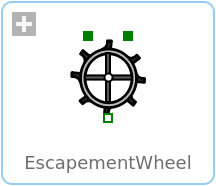WOLFRAM SYSTEM MODELER
EscapementWheelModel of clock escapement mechanism. |
|
Wolfram Language

SystemModel["IndustryExamples.ConsumerProducts.PendulumClock.Components.EscapementWheel"]

Information
Parameters (3)
Connectors (4)
| impulseFace |
Type: Flange_a Description: One-dimensional translational flange (left, flange axis directed INTO cut plane) |
|
|---|---|---|
| lockFace |
Type: Flange_a Description: One-dimensional translational flange (left, flange axis directed INTO cut plane) |
|
| flange_b |
Type: Flange_b Description: One-dimensional translational flange (right, flange axis directed OUT OF cut plane) |
|
| rflange_b |
Type: Flange_b Description: One-dimensional rotational flange of a shaft (non-filled circle icon) |
Used in Examples (2)
|
IndustryExamples.ConsumerProducts.PendulumClock Main pendulum clock example. Clock has one hand that takes one step each second. The movement is controlled by a counterweight. |
|
|
IndustryExamples.ConsumerProducts.PendulumClock Expanded pendulum clock setup with two hands, the relative motion of the hands are controlled by gear ratios. |
